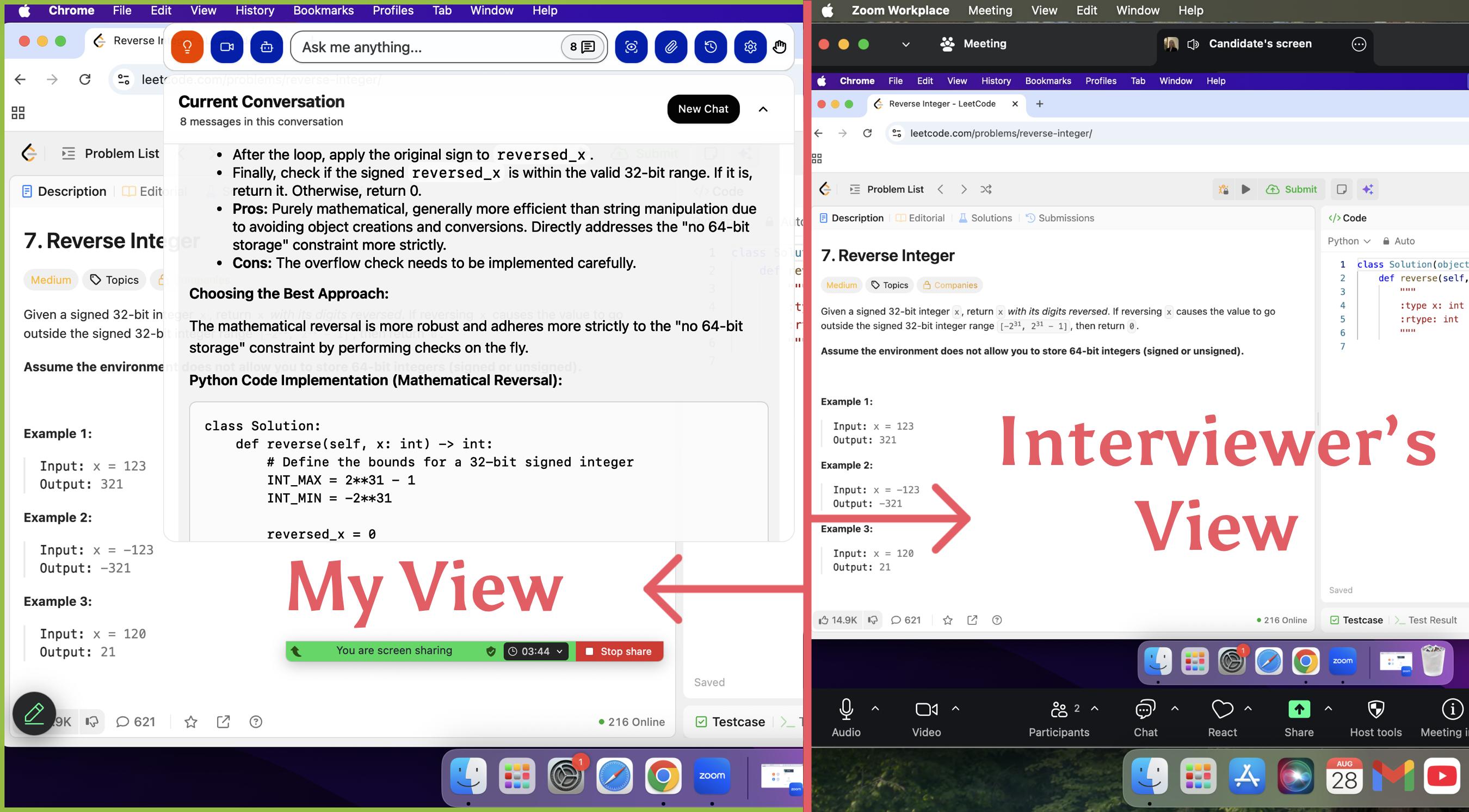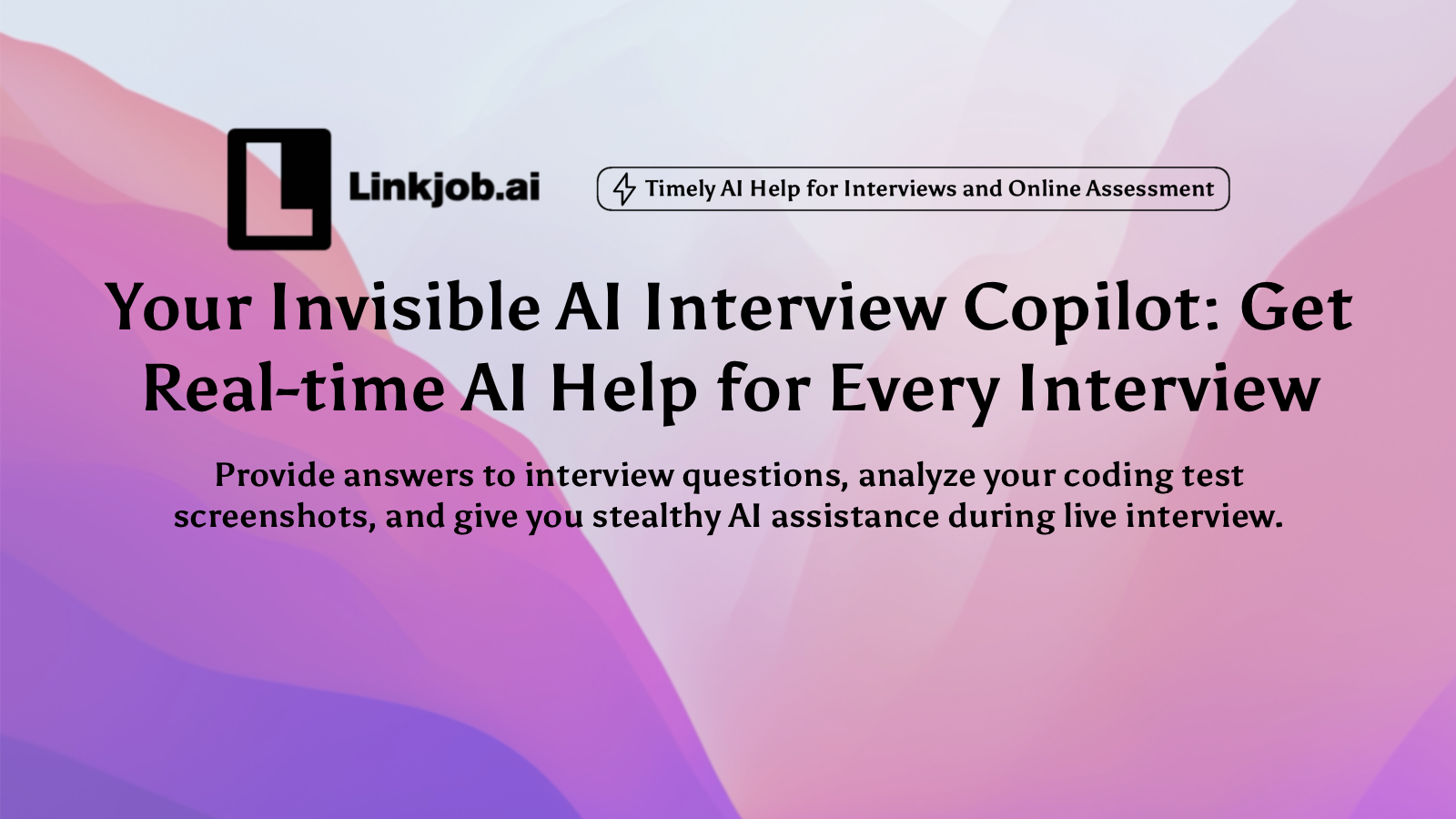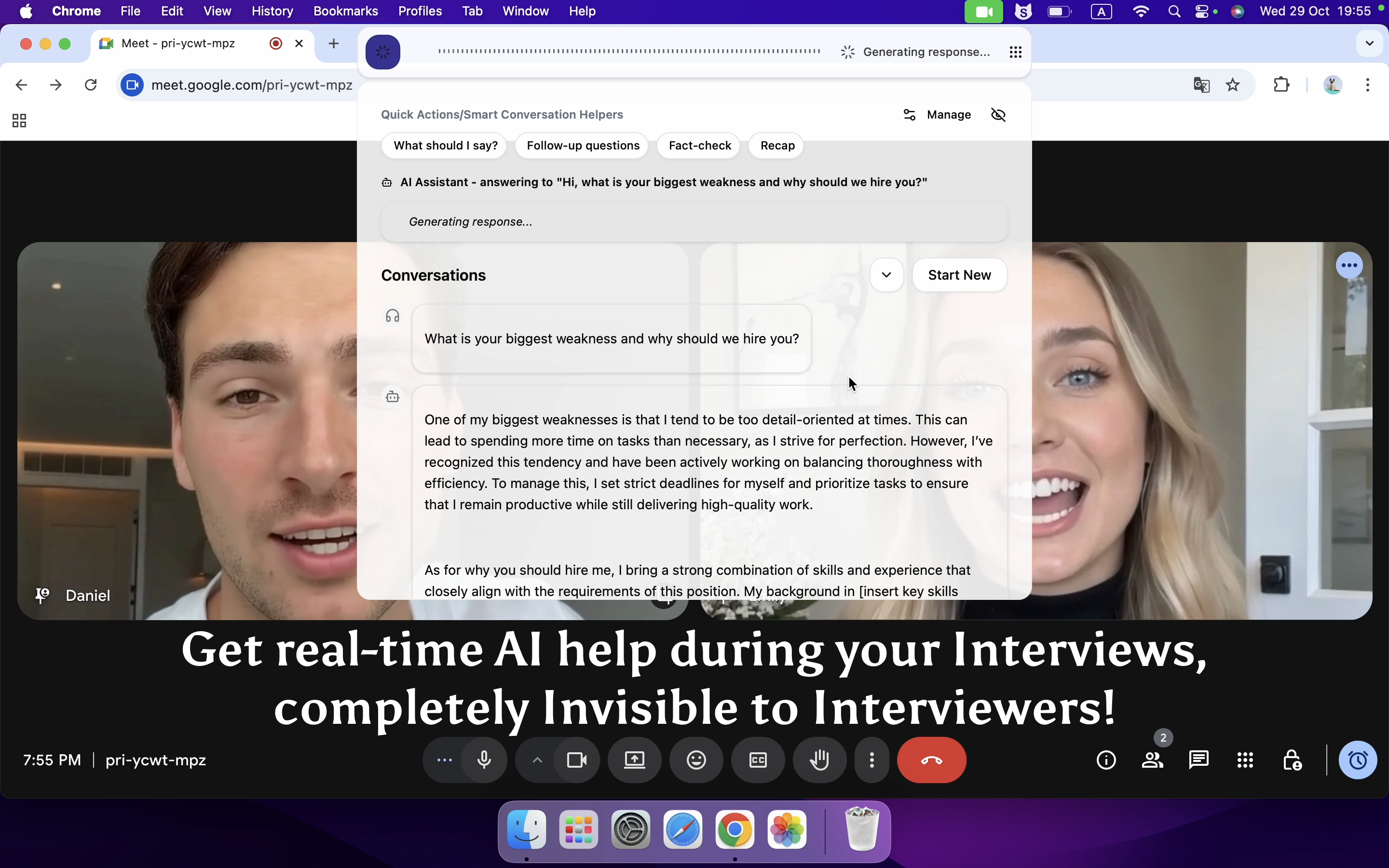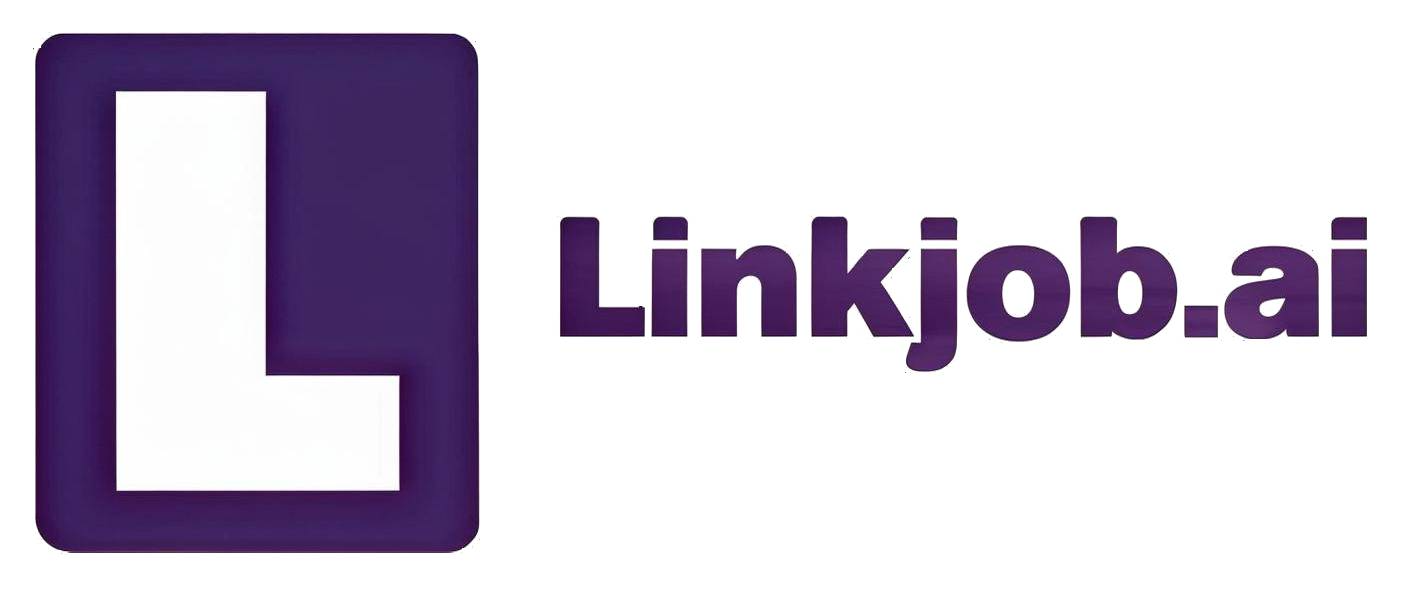Insider Tips for the Snapchat Interview Process Based on My Experience

In this guide, I’ll walk you through my own journey as a software engineer candidate, including the actual questions I faced and the structure of each stage. I’ve also collected insights into the data science interview process, along with a set of representative questions. To wrap it up, I’ll share some insider tips that helped me navigate the process more confidently and effectively.
During my interview preparation, the main tools I used were LeetCode and Linkjob. I relied on LeetCode to practice coding problems, while Linkjob helped me run mock interviews based on real question sets and even provided discreet, invisible AI assistance during live interviews without the interviewer noticing.
Snapchat Software Development Engineer Interview Process
Overall, the process was very smooth. The HR team was warm and responsive, replying to emails quickly, and the coordination team for scheduling was professional and very detail-oriented.
Recruiter Call
The recruiter call lasted about 45 minutes and was divided into two parts. The first part was a deep dive into one of my machine learning projects, covering details like the model used, pros and cons, how I started building the roadmap, and how many people collaborated on it. It felt like a mix of technical and behavioral questions. Since the role was for a senior position, I believe they were also looking for strong signals of leadership and ownership.
Technical Screen
The interviewer was a Korean engineer who began by digging into my resume. He asked me to pick the most impactful project I had worked on and present it using the Situation–Action–Impact (SAI) framework.
At first, I emphasized teamwork and project management aspects in my answer. However, the interviewer quickly steered the conversation toward technical depth and followed up with detailed questions. It seemed clear that he wanted to hear more about how I thought about and solved technical challenges.
For example, when I mentioned a challenge around handling traffic spikes caused by Hot Content, he asked specifically what optimizations I had implemented at both the caching layer and the database layer to ensure low latency and high availability.
On the algorithm side, he gave me a graph problem that wasn’t too difficult:
Problem: There are N rooms labeled from 0 to N-1. Each room is locked except for room 0.
You are given an array rooms, where rooms[i] is a list of keys found in room i. Each key rooms[i][j] is an integer representing the room it unlocks.
Return true if you can visit all rooms starting from room 0, otherwise return false.
The essence of the problem is to check whether the graph is fully connected—that is, whether all nodes are reachable from node 0. I quickly solved it using DFS.
The interview went smoothly and even finished about 10–15 minutes earlier than scheduled.

Onsite+BQ
The onsite consisted of several rounds, which can be grouped into Coding, System Design, and Hiring Manager (HM) Round. In each round, there were also about two behavioral questions, which I’ll describe in a separate section.
Coding Problem 1: Task Scheduler
You are given a character array tasks, where each character represents a CPU task. Each task takes exactly one unit of time to complete.
Between two tasks of the same type, there must be at least n units of cooldown time. During each unit of time, the CPU can either execute a task or remain idle.
Question: Return the minimum time needed to complete all tasks.
Follow-up:
If tasks have different priorities and high-priority tasks must always be executed before lower-priority ones, how would you modify your scheduling logic?
Coding Problem 2: Word Break
You are given a string s and a list of words wordDict. Insert spaces in s to construct valid sentences such that every word in the sentence is contained in the dictionary.
Question: Return all possible valid sentences.
Follow-up:
If wordDict is very large, the current recursive approach could be inefficient since each substring check may become costly. How would you optimize this?
System Design 1: Facebook Live Comments
Problem:
Design a real-time commenting system for live video streams (e.g., Facebook Live). Users should be able to:
Post comments in real time.
See new comments instantly without refreshing.
View past comments when joining a stream.
Constraints:
Millions of concurrent streams, each with thousands of comments per second.
Low latency (~200 ms) for real-time feel.
High availability preferred over strict consistency.
Discussion Points:
How to push comments to viewers (WebSockets vs SSE).
Handling comment history and infinite scroll.
Scaling to handle hotspots for very popular streams.
Ensuring smooth message ordering and avoiding duplicates.
System Design 2: Metrics Monitoring & Alerting System
Problem Description:
Design a metrics monitoring and alerting system that can collect, store, query, visualize, and generate alerts based on system metrics (e.g., CPU usage, memory, request counts). The system should support both real-time monitoring and historical analysis.
Input/Output:
Input: Continuous streams of metric data from servers, applications, and services.
Output:
Time-series metrics stored and available for querying.
Dashboards for visualization.
Alerts triggered and sent via email/SMS/Slack when thresholds or rules are met.
Constraints:
Must scale to millions of metrics per second.
Query latency should be low (near real-time for dashboards and alerting).
High availability (system should not lose metrics during failures).
Support flexible data retention policies (e.g., raw metrics for 7 days, aggregated metrics for 1 year).
Key Considerations:
Data ingestion model: Push vs pull (Prometheus vs CloudWatch style).
Storage: Use of time-series database (TSDB) for efficient read/write and compression.
Query layer: Efficient aggregation and filtering of metrics for visualization.
Alerting pipeline: Rule-based evaluation, alert manager, and notification system.
Scalability & reliability: Buffering via Kafka or message queues, horizontal scaling of collectors and storage.
Multi-tenancy & security: Support for multiple teams/services, access control, and isolation.

HM Round
In the HM round, I mainly discussed technical leadership, system design, and team culture fit with the team lead. From an experienced perspective, this round felt more like an in-depth technical discussion rather than a traditional behavioral interview.
The interviewer focused on how I made architectural decisions, optimized performance, handled complex or ambiguous requirements, and drove team collaboration in real projects. I shared specific problems I faced and the solutions I implemented, including trade-offs in technical approaches, resource allocation, and practical execution, which helped them get a clear sense of my engineering skills and thought process.
BQ
Walk me through a complex project you led or significantly contributed to. What was the most challenging technical aspect of it?
Tell me about a time you had to make a trade-off between short-term gains and long-term architectural health.
Snapchat Data Scientist Interview Process
While preparing for my interview, I also looked into the interview process and experiences for data scientist roles. I’ve organized these insights and am sharing them here as well.
Snapchat Data Scientist Interview Experience 1
Snapchat DS First-Round Phone Interview
This interview was scheduled after being reached out via LinkedIn.
Duration: 45-minute interview + 15-minute Q&A
Structure:
Self-introduction: Focused on the parts of the data scientist role I liked most and least in my past work.
A/B Testing Discussion: Described projects I had done, then elaborated on the pain points of experiment design from a DS perspective.
HackerRank Probability Questions:
Toss a fair coin 3 times. What is the probability of getting exactly two heads and one tail?
Rolling a dice, what is the expected number of tosses needed to get at least one of each side (1–6)?
SQL Question: Tested basic SQL skills, likely involving aggregations or joins.
Snapchat Data Scientist Interview Experience 2
Snapchat DS Multi-Round Interview
Round 1:
Duration: ~45 minutes
Content: SQL + experiment design question.
Calculated proportions of different user types. Required knowledge of CASE WHEN and percentage calculations.
Experiment design: Asked how to test the effect of Bitmoji stickers on messaging behavior—defining metrics and measurement approach.
Bar Raiser (~30 min): Introduction to Snap DS responsibilities and org structure, plus behavioral interview questions.
Round 2:
Duration: ~60 minutes
Content: Coding + experiment design
Discussed past work experience.
Asked detailed project questions from the angles of data, analysis, and modeling.
Coding question: Simple SQL problem.
Case question: Evaluating a Snap-designed advertiser-facing website—what metrics to measure design effectiveness.
Round 3:
Duration: ~60 minutes
Content: DS technical interview
Focused on ML and modeling.
Questions included model details from past projects.
Concepts tested: Random Forests (feature importance calculation), clustering, and other standard ML topics.
Snapchat Data Scientist Interview Experience 3
Snapchat DS Onsite (4 Rounds)
Stakeholder Round:
Interviewed with a PM.
Discussed an ongoing retention challenge. The interviewer kept asking for increasingly detailed steps beyond the initial approach.
Included ~10 minutes of behavioral questions.
Statistics Round:
One simple statistical problem.
One Bayesian probability calculation for a binary classification scenario.
Coding Round:
SQL question was straightforward (details not remembered).
Python problem: Given a long string (a paragraph), split it into substrings of length x without breaking words. If a word doesn’t fit, move it to the next substring.
Case Round:
Focused on evaluating ad performance on Snapchat.
Task: Compare two ad templates to determine which drives better results.
Started from defining success metrics and involved multiple follow-ups.

Different Types of Real Interview Questions
Here’s a summary of additional interview questions. I’ve organized these real interview questions by type.
Coding Problems
Problem 1: Minimum Cost to Assemble a File from Partial Copies
A file is stored across multiple machines. Each machine stores a partial segment of the file, defined by a start and end index, along with a cost associated with storing that segment. Some of these partial files may overlap.
Task: Determine the minimum total cost to assemble the complete file from the available partial segments.
Hint/Approach: This problem can be solved using dynamic programming. Consider intervals and overlaps carefully, and decide which combination of segments yields the minimum cost to cover the entire file.
Problem 2: Shortest Path in a Weighted Directed Graph
Given a weighted directed graph, find the shortest path from a start node to a target node.
Hint/Approach: Use Dijkstra’s algorithm. Maintain a priority queue to always pick the node with the current shortest distance, then update distances of adjacent nodes. This ensures that even when multiple paths exist, the algorithm finds the optimal path.
Problem 3: Ordered Message Processing
You are given a Message class with a sequence number and a DAO interface for storing and retrieving messages. Messages may arrive out of order, may contain duplicates, and some messages may be missing.
Task: Implement a function that processes messages in strictly increasing sequence number order.
Hint/Approach:
Keep a hash table to cache received but unprocessed messages.
Track the next expected sequence number.
When a message arrives:
If its sequence number matches the expected number, process it and increment the expected number.
After processing, check the cache to see if subsequent messages can now be processed in order.
Ignore duplicate messages.
Optionally, mark missing messages for later handling.
System Design
Design a Harmful Content Detection System
Build a system that can detect harmful content (e.g., hate speech, spam, or inappropriate media) across multiple platforms.
Functional requirements: ingest content in real time, classify it using ML models, flag or remove harmful content.
Non-functional requirements: low latency for real-time detection, high accuracy, and ability to scale to millions of users.
Considerations: model retraining, false positives/negatives, integration with moderation dashboards, and storage for flagged content.
Design a Video Streaming Platform
Design supporting millions of users.
Functional requirements: user authentication, content catalog, search, personalized recommendations, video streaming.
Non-functional requirements: scalability, low latency, high availability, and fault tolerance.
Considerations: caching frequently watched content, handling peak traffic, recommendation system, adaptive bitrate streaming, and monitoring system health.
Design a Data Ingestion System
Build a system to ingest and normalize data from various sources in different formats (structured, semi-structured, unstructured) for downstream processing.
Functional requirements: extract data from multiple sources, transform/normalize it, and store it for analytics or ML pipelines.
Non-functional requirements: scalability, reliability, and consistency.
Considerations: batch vs. streaming ingestion, schema evolution, error handling, and monitoring data quality.
Insider Tips for Snapchat Interview
Snapchat places strong emphasis on algorithmic skills and the ability to tackle ambiguous problems. For behavioral questions (BQ), focus on your thought process, as the work often involves vague requirements. Demonstrate logical problem decomposition, proactive validation, and flexible adjustments. Coding answers should not only be correct but also relevant to Snapchat’s business context (e.g., messaging systems, user behavior, ephemeral content), showing practical applicability.
As a cutting-edge tech company, Snapchat expects candidates to have solid technical foundations. Beyond algorithms and data structures, understanding deep learning frameworks (PyTorch/TensorFlow), model optimization, and distributed systems is highly valuable.
Remote interviews often require live coding. Interviewers evaluate code clarity, robustness, and efficiency. While practicing LeetCode is important, focus equally on writing high-quality, production-ready code in real projects.
Interviewers may pose open-ended or challenging problems to assess your ability to analyze, decompose, and solve problems step by step. Stay calm when facing difficult questions, break them into smaller parts, and communicate your reasoning with the interviewer.
Familiarize yourself with the company’s products, tech stack, and culture. Mentioning these during the interview demonstrates sincerity and genuine interest.
FAQ
How should I prepare for Snapchat’s coding interviews?
Answer: Focus on data structures and algorithms, especially graphs, arrays, and hash maps. Practice problems on LeetCode and HackerRank. Pay attention to real-world application of your solutions, like message handling or user behavior, since interviewers often ask how your code would fit Snapchat’s business context.
If you want to make the interview process easier, you can use Linkjob.ai. I tested it with a friend, and the results showed that interviewers cannot see the AI-generated real-time answers on my shared screen.
What is the best way to approach system design interviews at Snapchat?
Answer: Prepare for both high-level architecture and low-level system design. Be ready to draw workflows, explain your decisions on scalability, consistency, and throughput, and write pseudocode for critical components. Use real-world examples when possible, like designing a messaging pipeline or content filtering system.
See Also
My Experience of the Databricks New Grad Interview Process in 2025
My 2025 Cohere Interview Process and Actual Questions I Faced

